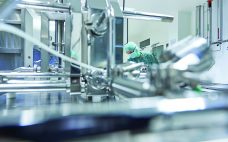Often we are pleasantly surprised at thematic connections that fall within an issue or come between an issue and its supplements — sometimes planned, sometimes a matter of happy coincidence. Setting an issue theme of continuous processing with a featured report on large-scale capacity strategies inevitably created some overlap. At this stage of maturation in its brief history, the biopharmaceutical industry offers myriad choices for facility design, process development, manufacturing paradigms, and partnering arrangements. With many successful examples to choose…
Wednesday, June 12, 2019 Daily Archives
Good Manufacturing Practice in China: Equipment Strategy and Quality Management to Compete with the West
Although the concept of good manufacturing practice (GMP) was created about half a century ago in the United States, the history of GMP biomanufacturing is relatively short in China, with the first version of GMP rules issued by the Ministry of Health in 1998. In 2010, the ministry issued its fourth version of China’s GMP rules, which came into effect in March of 2011 (1). According to a recent report from BioPlan Associates, the 2010 version raised the standards to…
The Role of Single-Use Polymeric Solutions in Enabling Cell and Gene Therapy Production – Part 3: Best Practices for Supplier Selection, Qualification, and Validation to Ensure Supply Chain Security
Bio-Process Systems Alliance (BPSA) was formed in 2005 as an industry-led international industry association dedicated to encouraging and accelerating the adoption of single-use manufacturing technologies used in the production of biopharmaceuticals and vaccines. Corporate members include plastic equipment suppliers, service providers, and users in the biopharmaceutical industry who share this mission. A key focus of BPSA’s core activities is to educate its members and others through sharing of information and development of best practice guides that help suppliers, users, and…
From Interest in Intensification to a Factory of the Future
Much has been published on improvements and advances in many individual technologies for biomanufacturing. If you take a comprehensive look at the field, however, you find overlap, muddling, and even contradiction about which particular processes or aspects of technological development should be designated properly as process intensification. Although the industry is addressing such distinct goals as improved manufacturing yield, product quality, and cost-effectiveness, the names of initiatives commonly applied to accomplish those goals overlap at best. Such ambiguity and lack…
An Integrated Bioprocess for Antibodies: From Harvest to Purified Bulk in Six Hours
Antibody production platform processes have been widely adopted in biomanufacturing, but many unit operations are not suitable for integration and automation. Here we describe the work of integrating unit operations by transforming a column operation to a more robust cassette format. We have selected a biomolecule-friendly buffer (phosphate) to eliminate, or delay, the performance of a circulating tangential flow ultrafiltration/diafiltration (UF/DF) operation, so the harvest-to-purified-bulk process can be integrated, resulting in a single, direct-flow operation, that reduces the batch process…
Making Downstream Processing Continuous and Robust: A Virtual Roundtable
Current biomanufacturing is driven to pursue continuous processing for cost reduction and increased productivity, especially for monoclonal antibody (MAb) production and manufacturing. Although many technologies are now available and have been implemented in biodevelopment, implementation for large-scale production is still in its infancy. In a lively roundtable discussion at the BPI West conference in Santa Clara, CA (11 March 2019), participants touched on a number of important issues still to be resolved and technologies that are still in need of…
Going Beyond the Simple Customer–Supplier Relationship: Ensuring a High-Quality Supply Chain Through Transparent Partnerships
Operating a successful global supply chain to deliver single-use systems (SUS) for utilization in the biopharmaceutical industry is complex. In his insightful article, Claudio Catallo, Head of Global Supply Chain Management FMT at Sartorius Stedim Biotech, details the company’s intelligent approach to supply chain management and the models it uses. He also explains how expert teams and integration of digitalization across many sales, manufacturing, and distribution sites maintain the operational excellence required to support supply and demand in an ever-changing…
Critical Considerations for Fill–Finish Manufacturing: Demand to Increase Speed and Flexibility While Maintaining Sterility Spurs Adoption of Novel Technologies
The global market for biopharmaceuticals continues to grow at a rapid pace, with a 9.5% compound annual growth rate (CAGR) predicted over the next eight years. That translates into more than $500 billion in projected growth. So it is no surprise that biopharmaceutical manufacturers are investing heavily in new facilities, technologies, and pipelines for manufacturing drug products. Even so, the need to prevent contamination places stringent handling and packaging requirements on biomanufacturers. Sterilizing equipment often requires steam autoclaves and dry…
On Continuous Chromatography: A Conversation with Sanofi’s George Weeden
George S. Weeden, Jr., is a scientist in global manufacturing science and technology (MSAT) process science at Sanofi. We recently chatted about the topic of continuous chromatography. What are the general reasons for companies to consider continuous chromatography? And what are the caveats? The main driver for considering continuous chromatography is reducing the cost of goods (CoG). Continuous chromatography improves productivity (mass of product per volume of stationary phase over time) and thus increases throughput or decreases volumes of stationary…
Ionis pledges to up its RNA game in SMA and elsewhere
Self-proclaimed pioneer of RNA-targeted medicine Ionis Pharmaceuticals says it is looking to develop an “even better medicine” to Spinraza to treat spinal muscular atrophy (SMA). At its annual meeting of stockholders earlier this month, Ionis Pharmaceuticals spoke about the success of its flagship molecule, Spinraza (nusinersen), an oligonucleotide approved by the US Food and Drug Administration (FDA) in December 2016 for the treatment of SMA. “Spinraza is the standard-of-care for all forms of the disease SMA. It is a medicine…








